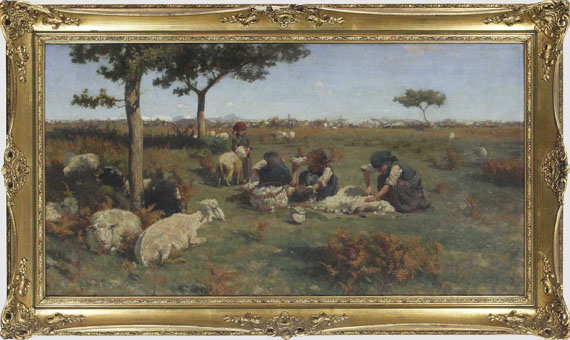Image du cadre
44
Stefano Bruzzi
Die Schafschur, Um 1885.
Oil on canvas
Estimation:
€ 18,000 / $ 20,880 Résultat:
€ 38,750 / $ 44,950 ( frais d'adjudication compris)
Die Schafschur. Um 1885.
Oil on canvas.
Signed in lower left. 51.2 x 96.5 cm (20.1 x 37.9 in).
Accompanied by a photo expertise from Mr Andrea Baboni, Correggio, who declared this work authentic upon viewing the original and on basis of own archive material. The work will be included into the archive's addenda to the catalog raisonné.
PROVENANCE: Galerie Commeter Hamburg, From the estate of a Hamburg art collector, May 2 - 5, 1928, los 673.
Kunst und Auktionhaus Hermann Combé, Stuttgart.
Private collection Southern Germany (acquired from aforementioned in 1969).
EXHIBITION: Esposizione Solenne della Società d'Incoraggiamento di Belle Arti nell'anno 1885, Florence 1885 (p. 14, cat. no. 127 "La tosatura..").
Oil on canvas.
Signed in lower left. 51.2 x 96.5 cm (20.1 x 37.9 in).
Accompanied by a photo expertise from Mr Andrea Baboni, Correggio, who declared this work authentic upon viewing the original and on basis of own archive material. The work will be included into the archive's addenda to the catalog raisonné.
PROVENANCE: Galerie Commeter Hamburg, From the estate of a Hamburg art collector, May 2 - 5, 1928, los 673.
Kunst und Auktionhaus Hermann Combé, Stuttgart.
Private collection Southern Germany (acquired from aforementioned in 1969).
EXHIBITION: Esposizione Solenne della Società d'Incoraggiamento di Belle Arti nell'anno 1885, Florence 1885 (p. 14, cat. no. 127 "La tosatura..").
The rural idyll of his home in the Lower Alps is the preferred motif of Stefano Bruzzi‘s paintings. Born at Piacenza in 1835, the nineteen-year-old went to Rome in order to study art. Bruzzi stayed for four years and studied painting with Alessandro Castelli, an artist specialized in neoclassical landscape painting. In Rome Bruzzi also came in contact with Nico Costa, through whom he became acquainted with Arnold Böcklin. In the following years Stefano Bruzzi visited his hometown Piacenza time and again and captured the rural surroundings and itspeople in his paintings. Bologna and Milan are further stops in the course of his artistic career, before he eventually settled with his family in Florence in 1874. At that point Bruzzi encountered the Macchiaioli, a group of painters that used “macchie" (literally patches or spots) as chief components for their works of art – a Tuscan variant of French Impressionism. This influence becomes particularly obvious in the specific painterly treatment in our painting: The broad canvas offers a panoramic view over a flat and vast plain with a snow-covered mountain range in the distance. Three sheep shearing women in the foreground are focused on their work while another young girl brings up the still unshorn sheep. The meadow‘s reddish brown fern leaves suggest that the scene depicts the autumn shearing. The sheep‘s summer wool is collected in a large basket at the center of the scene, the small water jug next to is offers welcome refreshment for the arduous work – the shearers have already rolled up their white sleeves above their elbows and the headscarfs offer protection from the sun. The swiftly speckled duct slightly blurs the figures‘ facial contours while it emphasizes the sheep wool‘s softness and the feathery fern in particularly natural manner. This way Bruzzi makes his impression of nature almost palpable. Towards the end of the century, in 1895, Stefano Bruzzi returns to his hometown for good and dies on January 4, 1911. [FS].
44
Stefano Bruzzi
Die Schafschur, Um 1885.
Oil on canvas
Estimation:
€ 18,000 / $ 20,880 Résultat:
€ 38,750 / $ 44,950 ( frais d'adjudication compris)




 Lot 44
Lot 44 